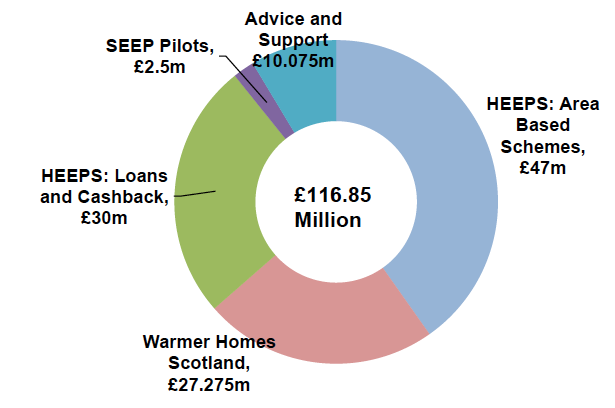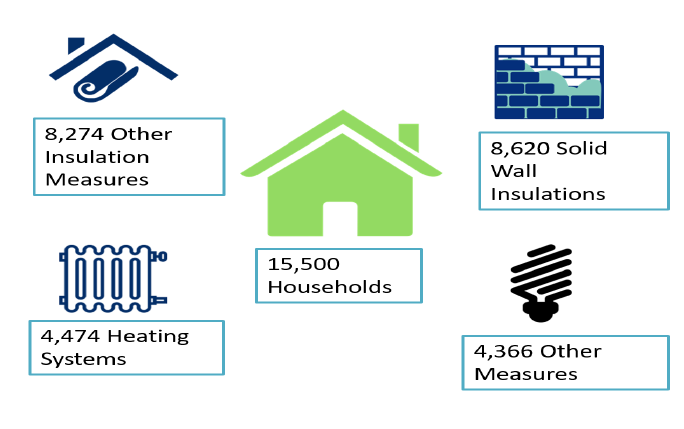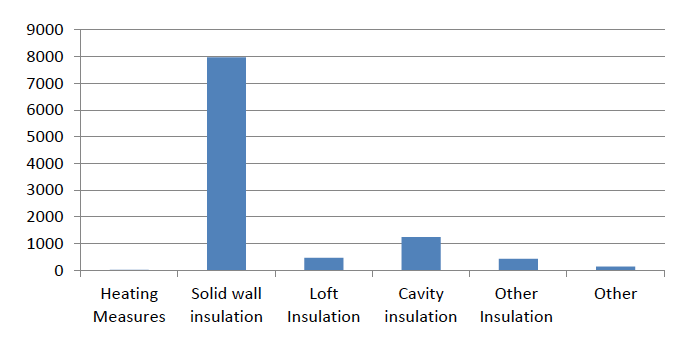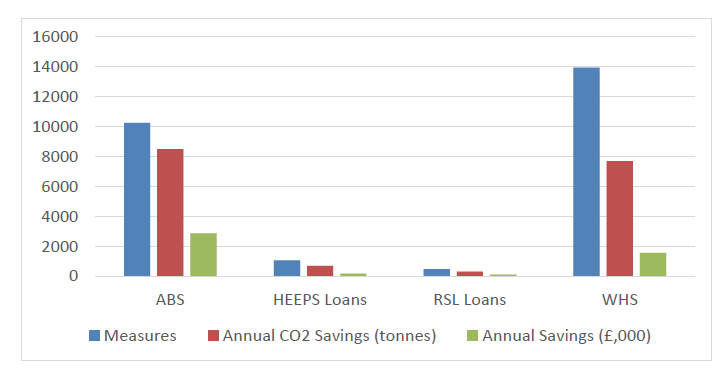Home Energy Efficiency Programmes for Scotland: delivery report 2017-2018
Fifth annual summary report of the HEEPS programme which includes the outcomes achieved from the 2017-2018 programme and an overview of cumulative progress since 2013.
Home Energy Efficiency Programmes for Scotland: Delivery Report 2017/18
Summary of Delivery in 2017/18
- Over 15,500 households were assisted in 2017/18 through our HEEPS programmes
- Approximately 27,734 energy efficiency measures installed in 2017/18 across our HEEPS programmes
- Annual CO2 savings of 17,200 tonnes and fuel bill savings of over £4.6 million
- Lifetime CO2 savings of 401,000 tonnes and fuel bill savings of approximately £129.8 million
Background
1. The Scottish House Condition Survey[1] (published 4 December 2018) indicates that around 613,000 households (24.9%) were in fuel poverty in Scotland in 2017.
2. Scotland's fuel poverty rate is now at the lowest rate recorded since 2005/06, according to the latest figures available. Between 2014 and 2017, 232,000 households moved out of fuel poverty and the rate reduced from 34.9% (845,000) to 24.9% (613,000).
3. The Home Energy Efficiency Programmes for Scotland (HEEPS) is the Scottish Government's flagship delivery vehicle for tackling fuel poverty and improving the energy efficiency of the domestic housing stock. Launched in April 2013, HEEPS provides an offer of support to all households across Scotland. The 2017/18 Programme had a total budget of £116.85m which funded a number of schemes, including advice and support.
4. This will be the Fifth annual summary report of our HEEPS programme. Its main focus is on the outcomes achieved from the 2017/18 programme, but it also provides an overview of cumulative progress since 2013, including the number of households assisted, and an overview of the results of our advice and support programme. Details on delivery through schemes prior to HEEPS and previous HEEPS Programme reports can be found on the Energy Saving Trust website.
Home Energy Efficiency Programmes for Scotland 2017/18
5. In line with recommendations from the Fuel Poverty Forum, the majority of Scottish Government's budget for fuel poverty and energy efficiency programmes is directed at Area Based Schemes (HEEPS: ABS). Area Based Schemes are delivered by local authorities targeting fuel poor areas, providing a range of insulation measures whilst focussing on harder to treat properties requiring more expensive interventions such as solid wall insulation. The budget for Area Based Schemes for 2017/18 was £47m.
6. The second element of HEEPS in 2017/18 was Warmer Homes Scotland (HEEPS: WHS). Warmer Homes Scotland offers fabric measures (such as insulation) as well as heating measures to improve the energy efficiency of the Scottish housing stock and to sustainably reduce fuel bills. For 2017/18 the WHS budget was £27.275m.
7. 2017/18 saw the continuation of HEEPS: Loans. HEEPS Loans schemes are open to all households across Scotland, helping to deliver a range of energy efficiency measures.
8. Additional grant funding for Energy Efficient Scotland pilot projects was made available in May 2017. Guidance on these projects asked local authorities to focus on innovative approaches to energy efficiency. This phase was open to considering more complex projects that reflected the challenges of integrated delivery. The 2017/18 SEEP Pilots budget from HEEPS was £2.5m.
9. The HEEPS programme also fund a free and impartial advice and support service to all householders in Scotland. This ensures that, where eligible, customers can be referred to the most appropriate scheme specific to their personal circumstances. The 2017/18 Advice and Support budget was £10.075m.
10. The individual HEEPS schemes are designed to work with other energy efficiency programmes by blending funding with other schemes, such as the Energy Company Obligation. This helps maximise the opportunities available to households and local authorities and means they can build larger funding pots to help deliver bigger or more expensive projects.
…now the house warms up so much more quickly, and best of all, it stays warm, especially upstairs, even when the heating's off. Everyone thinks it's nice and cosy now. The house looks a lot better too. And because so many houses have had it done, it's really brightened up the neighbourhood.
Mrs A – Scottish Borders
Figure 1: Breakdown of the 2017/18 HEEPS Budget

Main Outcomes
11. In total, across all our HEEPS schemes, over 27,700 measures were delivered to over 15,500 households across Scotland. Just over one third of measures installed were solid wall insulation, and almost 8,274 were other measures - the largest proportion of which was cavity wall insulation. In total, just over two thirds of measures delivered across HEEPS in 2017/18 were insulation measures with the remainder being heating (see Figure 2).
Figure 2: Breakdown of Measures Delivered by HEEPS in 2017/18

Delivery By Programme
Area Based Schemes (HEEPS: ABS)
12. The Home Energy Efficiency Programmes for Scotland: Area Based Schemes (HEEPS: ABS) are designed and delivered by Local Authorities, in conjunction with utility companies and local delivery partners, targeting fuel poor areas to provide energy efficiency measures to a large number of Scottish households to help reduce fuel poverty. It is primarily an insulation programme delivering solid wall and hard-to-treat cavity wall insulation.
13. Delivery is managed by local authorities who provide information to the Scottish Government on progress. HEEPS:ABS funding is provided for private sector properties only, although many schemes cover private sector properties in mixed tenure blocks. Enabling funding is provided to local authorities to assist in developing schemes, engage with householders and to contribute towards the cost of scaffolding etc. HEEPS:ABS funding often 'unlocks' larger mixed tenure schemes where a mix of social and private sector properties are involved. The figures collected from local authorities therefore include the number of social rented sector properties which received energy efficiency measures as part of HEEPS:ABS schemes.
14. Local Authorities are expected to use a range of sources of information to target households whose properties have the lowest levels of energy efficiency and/or highest levels of fuel poverty. It is up to each Local Authority to define the areas within which projects will deliver and the detail of those projects.
15. Figure 3, below, shows that HEEPS:ABS delivered large numbers of solid wall insulation (SWI). A total of 10,262 energy efficiency measures were installed in Scottish households, with SWI being installed in around 7,972 households. We can also see that local authorities deliver significant numbers of cavity wall insulation (CWI) and households received over 1,239 measures of this type. The nature of area based schemes means that large numbers of households receiving cavity wall insulation live in properties deemed hard-to-treat. This means that they cannot be filled using the same methods as standard cavity walls. Hard-to-treat properties typically have narrower cavities, are of non-traditional construction or are more than three storeys high. These features add to the complexity and cost of carrying out work of this nature. Over 988 measures (79%) of cavity wall insulation carried out through HEEPS:ABS is to hard-to-treat cavities.
The overall product has excelled our expectation, stopping all draughts and holding the heat for a greater sustained period. Also to our slight amazement the soundproofing of the product was an added extra. We have the aura of protection.
Mr S – Highlands ABS
Figure 3: Measures delivered by Area Based Schemes, 2017/18

Warmer Homes Scotland (HEEPS: WHS)
16. Warmer Homes Scotland is the Scottish Government's flagship national fuel poverty scheme. As a key part of the Home Energy Efficiency Programmes for Scotland, it is at the forefront of the Scottish Government's efforts to tackle fuel poverty by providing home energy efficiency measures to households who are living in, or at risk of living in, fuel poverty. The scheme achieves this by providing measures, including insulation, heating and micro-generation, to those households who are most in need of help to heat their homes.
17. Warmer Homes Scotland takes a 'whole house' approach to energy efficiency, often installing multiple measures to ensure homes are warmer and cheaper to run. More than 40 measures are available under this scheme including new energy efficient boilers combined with thermostatic heating controls, Air Source Heat Pumps, Solar PV and loft and cavity insulation.
18. The scheme is being delivered on a regional basis by Warmworks (including a separate Islands region) to ensure that all households, including those living in more remote parts of Scotland, get the same level of service.
19. In 2017/18, Warmer Homes Scotland helped 4,903 customers, who benefited from the installation of over 13,944 separate measures, giving them an average saving of £319 off their annual fuel bills. Details of these measures are highlighted in table 1 below.
20. The 2017/18 annual review of Warmer Homes Scotland will be available separately on the Scottish Government website.
HEEPS: Loans
21. HEEPS: Loans supports the provision of five loan schemes to deliver existing programmes. In 2017/18 the available loans budget was up to £30 million.
22. Home Energy Scotland (HES) Loans launched in May 2017 offering owner occupiers and some private sector landlords interest free loans of up to £15,000 per property, for the installation of a variety of energy efficiency measures such as solid wall insulation, double-glazing or a new boiler. In 2017/18 the scheme helped fund 845 households to install over 1064 energy efficient measures.
23. Registered Social Landlords (RSL) Loan offers interest free loan funding of up to £1 million to RSLs to support the installation of energy efficiency measures ino their stock. The scheme was open to all eligible social landlords in Scotland. Successful applications covered bids for funding the installation of solid wall insulation or hard to treat cavity wall insulation and/or energy efficient heating systems to assist them in achieving the Energy Efficiency Standard for Social Housing. Eleven social landlords received grants and installed just over 460 measures as a results.
24. The HEEPS Equity Loan is a pilot programme designed to help homeowners and private landlords make energy improvements and repairs to their properties. Energy Saving Trust is partnering with Care and Repair to deliver this scheme, and Care and Repair have been on hand to support householders throughout the process. The Equity scheme opened on 4th January 2017 and operated in Glasgow City, Argyll & Bute, and Perth & Kinross. To the end of March 2018 288 enquiries about Equity loans were received, 44 application forms were sent to applicants, and 13 loans offered.
25. HEEPS Area Based Scheme loan is an interest free loan tosupport householders with their contributions towards the cost of grant funded insulation measures delivered through the Scottish Governments HEEPS ABS programme.
26. HEEPS Warmer Homes Scotland loan is an interest free loan available to qualifying homeowners and private sector tenants who are identified as living in or at risk of fuel poverty and who are required to pay a contribution towards the costs of installation measures such as, insulation, heating and micro-generation measures.
Table 1: Measures Delivered Across the HEEPS Programmes
| WHS | ABS | HEEPS: RSL Loans | HEEPS: Loans | Total | |
|---|---|---|---|---|---|
| Heating System | 3,711 | 19 | 150 | 594 | 4,474 |
| Other Heating Measures | 4,256 | 2 | 0 | 108 | 4,366 |
| Solid wall insulation | 163 | 8,110 | 275 | 72 | 8,620 |
| Other insulation measures | 5814 | 2,131 | 39 | 290 | 8,274 |
| Total Measures | 13,944 | 10,262 | 464 | 1,064 | 25,734 |
| Total Households | 4,903 | 9,749 | TBC | 845 | 15,497 |
SEEP Pilot Schemes
27. During this initial phase of the SEEP Programme, in January 2016 funding was made available to local authorities to test delivery mechanisms for domestic and non-domestic buildings to inform the future design of the programme.
28. This Pilot programme asked local authorities to produce path-finding energy efficiency projects across both domestic and non-domestic markets over 2 years. The Scheme aimed to encourage local authorities to work across departments, combining domestic and non-domestic areas.
29. Phase 2 of the SEEP Pilots launched in May 2017, and focused on innovative approaches to energy efficiency. This phase was open to considering more complex projects that reflected the challenges of integrated delivery.
30. The 2017/18 SEEP Pilots budget form Housing was £2.5m and a total of 18 local authorities made successful applications to the fund. These projects were a mix of domestic and non-domestic, with some heat decarbonisations and the first batch of Local Heat and Energy Efficiency Strategies. These projects have yet to be evaluated
31. A full evaluation of the first phase of SEEP pilots was produced by the Energy Savings Trust and the University of Edinburgh in the Summer of 2018 and is available online[2]. Information on outcomes is therefore not included in this report.
Advice and Support: Home Energy Scotland
32. It is recognised that alongside funding for physical measures, we also need to ensure householders are guided through the choices available to them. In 2017/18 the HEEPS programme made available £7.81m to fund Home Energy Scotland (HES),
Home Energy Scotland;
- Provides free and impartial advice on energy efficiency measures to all householders in Scotland including advice on schemes they may be eligible for. In 2017/18 HES handled over 31,500 contacts in regards to HEEPS schemes. These are detailed in table 2 below;
- can provide tailored advice for an individual's own home;
- can assist householders through the complaints process of Government energy efficiency schemes;
- offers every caller a free benefits check to ensure householders are receiving all the help and support they are entitled to. This initiative has unlocked a total calculated increase in income from Benefits Check of £7,499,114 over the whole term of this contract;
- provides a community liaison service to join up with other service providers to reach the most vulnerable people in the community. HES provided 871 home visits to vulnerable households in 2017/18;
- has developed an online referral portal to enable seamless referrals from external stakeholders to HES. The portal also allows stakeholders to track progress with the referral to the outcome for the customer.
33. Home Energy Scotland also offers an impartial supplier-switching support service delivered through a partnership with the social enterprise Citrus Energy. Citrus Energy identifies the best energy supply deal for the customer from the widest range of energy suppliers and completely manages the switching process from start to finish. This service resulted in figures of :
- Total 2017/18 savings (projected) as reported to EST by Citrus: £57,029
- Average saving (projected) for customer switching as reported to EST by Citrus: £225.00 .
Table 2: Engagement with Home Energy Scotland in 2017/18
| Calls and advice or referrals | 2017-18 |
|---|---|
| Households in contact about Home Energy Efficiency Programmes for Scotland | 31,598 |
| Take-up of offers of help | |
| - households | 27,130 |
| - people in households | 53,867 |
| Energy saving advice (households) | 23,459 |
| Income maximisation referral (people) | 536 |
| Energy cost reduction referral (WHD) | 3,483 |
| Benefit Calculator Signposting | 8,019 |
| Energy supplier switching referral (Citrus) | 7,112 |
| Area-based (HEEPS-ABS) referrals (households) | 3,570 |
| Other obligated supplier scheme referral including HHCRO (households) | 323 |
| Warmer Homes Scotland referrals (households) | 6,597 |
| WHS referrals reinstated by Warmworks | 0 |
| WHS referrals reinstated by EST on appeal | 171 |
HES Homecare Pilot
34. HES Homecare Pilot launched in 2017, following a recommendation by the Scottish Rural Fuel Poverty Task Force, to provide targeted, face-to-face advice and support within the home.
35. The pilot builds upon the well-established Care and Repair model to deliver housing improvements alongside energy efficiency improvements, including advice on tariffs and switching. It was locally based and delivered and worked on the delivery of a holistic service through partnerships with housing, health and social care and energy companies.
36. The HES Homecare pilot has now been evaluated. The next steps will be to mainstream into the advice provision delivered by Home Energy Scotland on a Scotland wide basis from April 2019.
"I am delighted with the resultant works. my heating is not on for as long now and that my home feels warmer even when the heating system is off!"
Miss C - Glasgow
Carbon and Fuel Bill Savings
37. The installation of the energy efficiency measures make a significant contribution to reducing CO2 emissions from Scottish housing and to helping households save money by reducing their fuel bills. As Figure 4 shows, each programme contributes to reducing household fuel bills and CO2 emissions. Figure 4 below shows that the 2017/18 programme resulted in annual CO2 savings of 17,200 Tonnes, and fuel bill savings of over £4.6m.
Figure 4: Annual Fuel Bill and CO2 Savings from HEEPS Measures

38. Installing energy efficiency measures also has long term benefits for households as the resulting improvements help lower fuel bills and reduce carbon emissions for the lifetime of the measure. Over the lifetimes of the measures installed, the 2017/2018 HEEPS programmes will save 401,000 tonnes of CO2 and reduce fuel bills by almost £129.8m .
Delivery of the Energy Company Obligation (ECO) in Scotland.
39. Our HEEPS schemes operate within a broader landscape of energy efficiency programmes operated by the UK Government. Our Area Based Schemes in particular are designed to work in tandem with the Energy Company Obligation (ECO) to provide a blend of funding which can help develop larger schemes and assist the greatest number of households possible.
40. ECO is also a key source of additional leveraged funding to Warmer Homes Scotland. This is managed centrally by Warmworks, our managing delivery agent, on behalf of the supply chain.
41. Just over £1m of ECO funding was leveraged into Warmer Homes Scotland in 2017/18. This is a huge increase over last year, and an area where Warmworks are focusing.
42. ECO funding is also typically blended with HEEPS: ABS and we expect local authorities to leverage ECO to support delivery. During 2017/18 Scottish local authorities have reported that they have leveraged over £6.5m ECO funding to contribute towards HEEPS:ABS schemes
43. From April 2017 to March 2018 almost 32,685 ECO [3] eligible measures were installed in Scotland. We do not have a full breakdown of the measures delivered for this period. Scotland received 17.15% of total UK ECO measures in the year 2017/18. The amount spent here can be estimated at either £49.41 million excluding admin costs, or £57.61 million if admin costs are included. Given that around £7.5m of this spending was in conjunction with our HEEPS schemes it is clear that there is substantial additional energy efficiency activity happening in Scotland outside our programmes.
"I really feel the cold, so I liked the thought of having a warmer house, and I thought having the external wall insulation would make the house look better too. But it's really expensive to have it installed, so the deciding factor for me was that it was heavily subsidised. I couldn't have had it done otherwise. In the end I paid £1000, which has been worth it already."
Mrs A – Scottish Borders
HEEPS Since 2013/14
44. Since its launch in 2013, across the four years in which it has operated over 135,000 households throughout Scotland have benefited from receiving energy efficiency measures through our HEEPS programmes. Over the lifetime of the measures installed these Scottish households will cumulatively save over £854 million pounds in their fuel bills and over 3.4 million tonnes of CO2.
45. The Scottish Government's investment in HEEPS between 2013/14 and 2017/18 is now over £519m. Similar levels of ECO have also been invested in this period resulting in overall investment in tackling fuel poverty and improving energy efficiency in Scotland in excess of £900 million.
- Total HEEPS Investment of over £519 million
- over 135,500 households assisted by HEEPS since 2013
- over 3.4 million tonnes of CO2 saved by our HEEPS programmes
- £854 million savings in household fuel bills by HEEPS
Conclusion
46. Looking across all of the 2017/18 HEEPS programmes covering advice, support and assistance with energy efficiency measures we can be confident therefore that almost 47,000 households have benefited. Many of these households will have benefited from multiple interventions including the installation of measures, advice on reducing fuel bills, tariff switching and income maximisation. This package of assistance will help make a significant contribution to immediate and long-term reductions in fuel bills and to households enjoying warmer homes.
47. The HEEPS programme has, since 2013, helped make a significant contribution to the Scottish Government's commitment to tackling fuel poverty. Over 135,000 households now live in homes which are warmer and cheaper to heat as a result of the measures installed and the effects of these changes will benefit households for many years to come. The programme also helps towards the Scottish Government meeting its climate change targets by reducing CO2 emissions and we know that our advice and support service helps households save on their fuel bills.
48. We continue to take a cross-cutting approach, including working with the health sector to promote the support available to tackle fuel poverty. Through Home Energy Scotland we have prioritised increasing the number of referral pathways to the support we offer from health related organisations. This is helping to ensure more households, particularly those where a person is especially at risk of suffering adverse effects of living in a cold home, get the help they need to live in a warm home that is affordable to heat.
Contact
Email: SGareabasedschemes@gov.scot
There is a problem
Thanks for your feedback